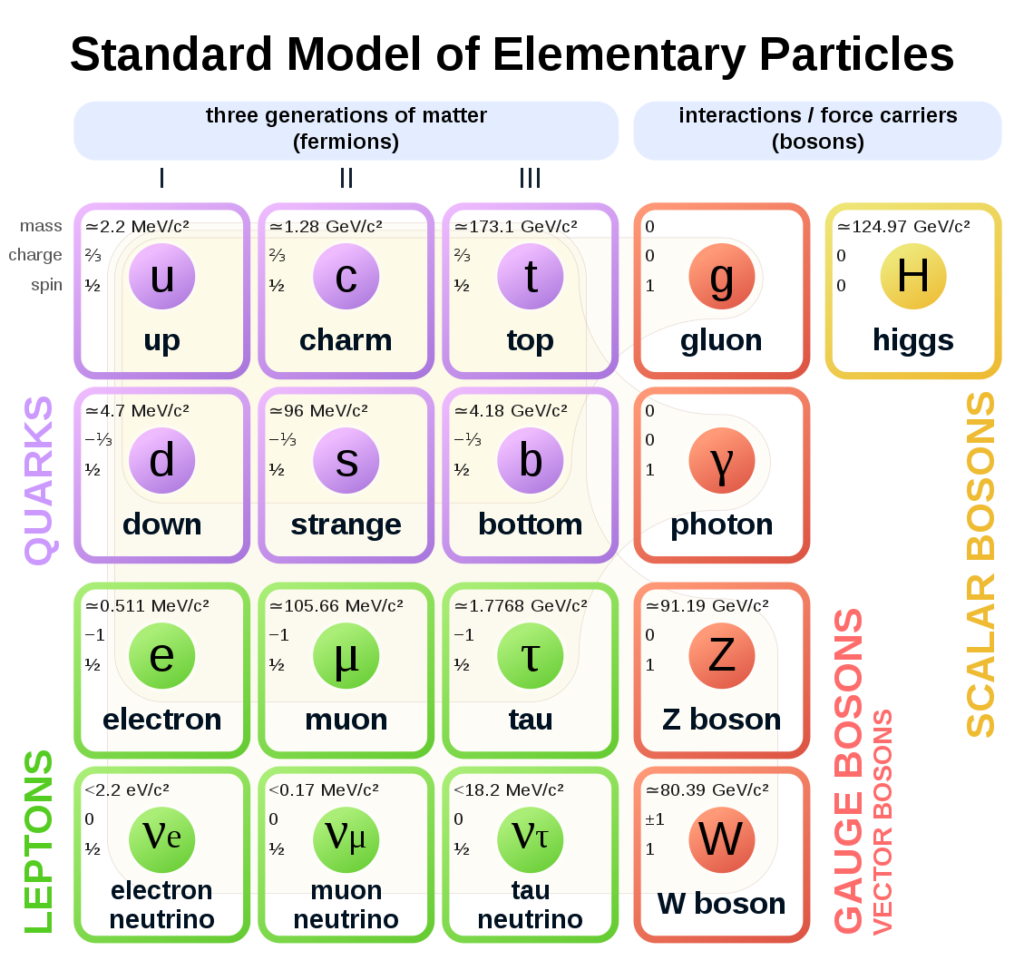Over the weekend, I started reading Sean Carroll’s The Particle at the End of the Universe. Well written [1]. At times his colloquial description of a concept prompted me to: (1) wonder if he was referring to a particular technical phenomenon; and (2) explore the specialized, technical background of that concept. In either case, quite a wild ride into the history and mathematical underpinning of modern physics.
An example of the first case is Carroll’s remark that in the Standard Model smaller mass means more occupied space — larger effective size: “… the smaller the mass of the particle, the more space it takes up. … Every [quantum] wave has a wavelength, which gives us a rough idea of its size.”
So lower masses mean less energy mean longer wavelengths mean larger sizes; higher masses mean more energy mean shorter wavelengths mean smaller sizes. — Carroll, Sean (2012-11-13). The Particle at the End of the Universe: How the Hunt for the Higgs Boson Leads Us to the Edge of a New World (Kindle Locations 558-559). Penguin Publishing Group. Kindle Edition.
So, I wondered if he was merely referring to matter waves — the de Broglie wavelength (the wavelength, λ, is inversely proportional to its momentum, p, through the Planck constant, h).
Another example is his analogy to sound waves.
Just like sound waves propagate through the air, vibrations propagate through quantum fields, and we observe them as particles. — Ibid (Kindle Locations 554-555).
When you listen to (receive) air pressure (compression) waves closely enough, they resolve into (are perceived or heard as) individual sounds, eh. So, I reviewed longitudinal / transverse mechanical waves (vs. EM waves).
In the second case, I explored the concept of symmetry, which branched out to many other terms, mathematical frameworks, and historical milestones in the field (below).
“Once you believe in these symmetries, …” — Ibid (Kindle Location 532).
Wiki: “Symmetry in physics has been generalized to mean invariance—that is, lack of change—under any kind of transformation, for example arbitrary coordinate transformations. This concept has become one of the most powerful tools of theoretical physics, as it has become evident that practically all laws of nature originate in symmetries.”
Wiki: “In fact, this role inspired the Nobel laureate PW Anderson to write in his widely read 1972 article More is Different that ‘it is only slightly overstating the case to say that physics is the study of symmetry.'”
Anderson wrote [2]: “By symmetry we mean the existence of different viewpoints from which the system appears the same. … Symmetrical as it is, a crystal is less symmetrical than perfect homogeneity.”
- Symmetry
- Invariant (physics) — e.g., space as homogeneous and isotropic. [3]
- Wigner’s classification — mass eigenvalues, to classify particles and fields in physics.
- Noether’s theorem — every differentiable symmetry of the action of a physical system has a corresponding conservation law.
- Partial differential equation
- Philip Warren Anderson (and a brief paper “More Is Different”)
- Higgs mechanism — A theory able to finally explain mass generation without “breaking” gauge theory was published almost simultaneously by three independent groups in 1964 …
- Tachyonic field — a quantum field with an imaginary mass. …the imaginary mass creates an instability in the configuration: any configuration in which one or more field excitations are tachyonic will spontaneously decay, and the resulting configuration contains no physical tachyons.
- Tachyon condensation — a process in particle physics in which a system can lower its energy by spontaneously producing particles. The end result is a “condensate” of particles that fills the volume of the system. Tachyon condensation is closely related to second-order phase transitions. … examples of tachyonic fields amenable to condensation are all cases of spontaneous symmetry breaking. In condensed matter physics a notable example is ferromagnetism; in particle physics the best known example is the Higgs mechanism in the standard model that breaks the electroweak symmetry.
The previous day, I explored electron and vibration, which branched out to a review of the wave function — how EM waves propagate. Particularly, since Carroll used an analogy that quantum field vibrations propagate like sound waves (above).
- Tractor beam
- Electron
- Anomalous magnetic dipole moment
- Simple harmonic motion
- Oscillation
- Vibration
- Randomness
- Periodic motion
- Continuum mechanics
- Normal mode
- Superposition principle
- Fourier analysis
- String theory
- Bosonic string theory
- How does string theory predict gravity?
- Point particle
- Wave packet
- Wave equation
- Periodic traveling wave
- Wave function
- Complex-valued function
- Position and momentum space
- Plane wave
- Antenna (radio) — near field, far field
- Transverse wave
- Near and far field
- Bohr radius
- Quantum wave
- Matter wave
- Plack constant
- Wavelength of a baseball
- Visible light wavelength
- Visible spectrum
- Orders of magnitude
- Hertz
More to come.
[1] Peppered with words that are not used everyday, like gargantuan, behemoth, oomph, ham-fisted.
[2] Science, New Series, Vol. 177, No. 4047. (Aug. 4, 1972), pp. 393-396. See: http://robotics.cs.tamu.edu/dshell/cs689/papers/anderson72more_is_different.pdf
[3] Hence, the principle of mediocrity, as discussed (with video) in this Space.com article.

